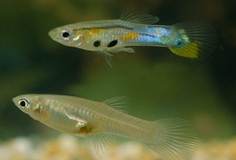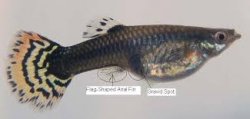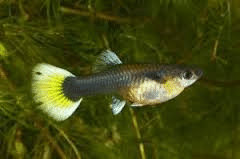mystichorseangel
Mostly New Member
I have seen numerous topics such as "is my guppy pregnant?" or "how do I breed guppies?"/"why do my guppies not breed?" as well as the "how do I take care of my fry?" And I thought a basic guide should be written.
My experience comes from a wide variety of research and reading, as well as breeding guppies on the side of my fish hobby.
First off, guppies are probably one of the easiest fish to breed, however you have to know what gender fish you are getting. Also, after you purchase females, remember they are probably pregnant when you get them for at least six months due to their ability to store sperm.

(http /www.google.com/url?sa=i&rct=j&q=&esrc=s&frm=1&source=images&cd=&cad=rja&docid=Gy7ObqJHZJUSkM&tbnid=R_IKqVfpFUMO8M:&ved=0CAUQjRw&url=http%3A%2F%2Fgvsu.edu%2Frmsc%2Finterchange%2F2013-february-connections-718.htm&ei=LySlUobaO9GzkAe5j4HoCw&bvm=bv.57752919,d.eW0&psig=AFQjCNHmDwGI8FrP6f2VAwGzuRUu9RSmTg&ust=1386640745899813)
/www.google.com/url?sa=i&rct=j&q=&esrc=s&frm=1&source=images&cd=&cad=rja&docid=Gy7ObqJHZJUSkM&tbnid=R_IKqVfpFUMO8M:&ved=0CAUQjRw&url=http%3A%2F%2Fgvsu.edu%2Frmsc%2Finterchange%2F2013-february-connections-718.htm&ei=LySlUobaO9GzkAe5j4HoCw&bvm=bv.57752919,d.eW0&psig=AFQjCNHmDwGI8FrP6f2VAwGzuRUu9RSmTg&ust=1386640745899813)
The guppy at the top of the picture is a male, as seen by his extravagant coloration and as well as the rod shaped "fin"
near the base of his tail. This fin is called a gonopodium, and is the male's sexual organ. The lower fish is the female, this female is a good specimen, showing typical attributes of the wild type, being predominantly grey. While you can find fancy pet store guppies that have bright tails, the females are generally duller and less flashy than the males. On top of that females have a fan shaped fin at the base of the tail, as well as a brown discoloration around the anal area, this is called the "gravid spot" and is where, when the female is pregnant, it becomes almost black from the fry's eyes. (seen below)

(http /www.google.com/url?sa=i&rct=j&q=&esrc=s&frm=1&source=images&cd=&cad=rja&docid=8hW1toskfoWzAM&tbnid=IBCYj_UQrpriFM:&ved=0CAQQjB0&url=http%3A%2F%2Famericanguppies.blogspot.com%2F&ei=aiilUq-xLdDrkQeKyYGQDA&bvm=bv.57752919,d.eW0&psig=AFQjCNHAklW9g3eq0DljzncbPbFXLXkFtA&ust=1386641860228562)
/www.google.com/url?sa=i&rct=j&q=&esrc=s&frm=1&source=images&cd=&cad=rja&docid=8hW1toskfoWzAM&tbnid=IBCYj_UQrpriFM:&ved=0CAQQjB0&url=http%3A%2F%2Famericanguppies.blogspot.com%2F&ei=aiilUq-xLdDrkQeKyYGQDA&bvm=bv.57752919,d.eW0&psig=AFQjCNHAklW9g3eq0DljzncbPbFXLXkFtA&ust=1386641860228562)
Typical behavior of male guppies is to constantly chase the females in an attempt to breed. Because of this "affectionate" behavior, a good rule of thumb for guppies is to have a females to males ratio of 2:1, or for every one male guppy, two females. I prefer 3-4:1, but if you have limited tank space, the minimum is 2:1, this will help your females not get so stressed by the male(s) and thus can result in a greater reaping of fry.
For the most part the guppies will breed on their own. What I personally prefer to do is separate my males and females so I can selectively breed them, this reduces the amount of inbreeding; inbreeding is crucial to avoid, since inbreeding can result in some crazy looking fish, and not only will they be defective, but they wont live very happy or productive lives. When I selectively breed, I write down which male and female I bred, and after the babies grow, I write what the strain I got was. (strain is a term referring to the color/appearance of the fish) This is so I can further reduce inbreeding.
Here are some guppies with bent spines due to inbreeding.

(http /www.google.com/url?sa=i&rct=j&q=&esrc=s&frm=1&source=images&cd=&cad=rja&docid=vvr2Zh1pkGbEkM&tbnid=5lc1EgXG9Gkj6M:&ved=0CAUQjRw&url=http%3A%2F%2Fwww.aquariumadvice.com%2Fforums%2Ff12%2Finbred-guppy-192139.html&ei=HyelUu-GJ8WtkAeEzIHIDw&bvm=bv.57752919,d.eW0&psig=AFQjCNHqeg2Nm7WcYBqziZZa3fEzAUUipQ&ust=1386641542166790)
/www.google.com/url?sa=i&rct=j&q=&esrc=s&frm=1&source=images&cd=&cad=rja&docid=vvr2Zh1pkGbEkM&tbnid=5lc1EgXG9Gkj6M:&ved=0CAUQjRw&url=http%3A%2F%2Fwww.aquariumadvice.com%2Fforums%2Ff12%2Finbred-guppy-192139.html&ei=HyelUu-GJ8WtkAeEzIHIDw&bvm=bv.57752919,d.eW0&psig=AFQjCNHqeg2Nm7WcYBqziZZa3fEzAUUipQ&ust=1386641542166790)
If you choose to do some selective breeding, you probably won't see the guppies breed. So what I do is move the male and female into a ten gallon breeding tank and leave them alone for a few days. Be sure the breeding tank is the same temperature and relative pH as the other two to minimize stress on the fish, which would result in a longer wait for them to breed. Once in the tank I choose to leave the two there for about a week. Monitor the female often, as well as your other females incase they may have impregnated themselves with stored sperm. After a week of being together she should be pregnant. move the two back to their respective tanks, acclimating them as necessary.
Here is a non-pregnant female guppy.

(http /www.guppies.com/forums/showthread.php/35361-So......)
/www.guppies.com/forums/showthread.php/35361-So......)
Here is a guppy that is just starting to swell up

(http /www.google.com/url?sa=i&rct=j&q=&esrc=s&frm=1&source=images&cd=&cad=rja&docid=rzSSj7jZ9OVwhM&tbnid=0naa6Ms0vds_cM:&ved=0CAUQjRw&url=http%3A%2F%2Fsmall-pets.lovetoknow.com%2Fpregnant-guppy-fish&ei=WSqlUtOPDZOskAem9oDoCQ&psig=AFQjCNGJ83RxZkWhBeGwcfpeM-N80OkhNw&ust=1386642244152096)
/www.google.com/url?sa=i&rct=j&q=&esrc=s&frm=1&source=images&cd=&cad=rja&docid=rzSSj7jZ9OVwhM&tbnid=0naa6Ms0vds_cM:&ved=0CAUQjRw&url=http%3A%2F%2Fsmall-pets.lovetoknow.com%2Fpregnant-guppy-fish&ei=WSqlUtOPDZOskAem9oDoCQ&psig=AFQjCNGJ83RxZkWhBeGwcfpeM-N80OkhNw&ust=1386642244152096)
This female should drop any hour now! Note how she is squared off and her gravid spot is very dark.

The gestation period for a guppy is around 21-30 days. Once your female is huge, she should drop any day now. Here is where the controversy comes in. To use a breeder box, or not? Some will say it is stressful to the fish, and will cause her to delay dropping her fry, while others will say it is an easy way to breed guppies. I keep my females in a breeding tank from the moment I notice they are pregnant. This way they are used to the environment and they can drop their fry when they are ready without the stress of moving into a small cramped box that is unfamiliar to them. Do what you think is best, and more importantly what you can afford and maintain. If you choose to keep them in the main tank, be sure it has lots of plants and places for little fry to hide so they don't get eaten by your other fish. Your guppies will drop their fry over several hours. After they are born, unless you keep them in the main tank, separate the female and return her to her main tank once you are positive she is done dropping fry. An average litter is 20-30 fry.
Here is where I merge from the mother and into the care of the babies! (I would hope you know how to care for your adult guppies
 )
)
Baby guppies have very tiny mouths and weak fins. On top of that, they are, well, tiny!!! A big bad filter would eat all of your fry right up!
 we certainly don't want that. So for baby fry a nice safe sponge filter will do well, as long as there is minimal water disturbance, they aren't the best swimmers at first
we certainly don't want that. So for baby fry a nice safe sponge filter will do well, as long as there is minimal water disturbance, they aren't the best swimmers at first
 So you can feed the fry a variety of things. I feed my babies the same flakes I feed their mommas, tropical flake food with color enhancers. Now baby fry don't have any color or distinctive gender at the beginning, so the color part doesn't matter. Baby brine shrimp are also an acceptable food, as well as some commercial baby guppy food you can find at a pet store. I personally like Hikari products. For the flakes, crush them up as fine as you can get and sprinkle that over the tank. What I do is slightly disturb the water so they fall for the weaker babies that stay on the bottom. I keep my breeding tanks bare so the babies are highest quality, and it is easier to keep clean in my opinion. (I apologize for not having a picture, I couldn't find any that were small enough to upload
So you can feed the fry a variety of things. I feed my babies the same flakes I feed their mommas, tropical flake food with color enhancers. Now baby fry don't have any color or distinctive gender at the beginning, so the color part doesn't matter. Baby brine shrimp are also an acceptable food, as well as some commercial baby guppy food you can find at a pet store. I personally like Hikari products. For the flakes, crush them up as fine as you can get and sprinkle that over the tank. What I do is slightly disturb the water so they fall for the weaker babies that stay on the bottom. I keep my breeding tanks bare so the babies are highest quality, and it is easier to keep clean in my opinion. (I apologize for not having a picture, I couldn't find any that were small enough to upload
 ) In the first week they wont grow very much, but more so will begin developing those swimming muscles. Within the first two weeks the weaker fry will begin to show their weakness. The best thing to do here is to scoop them out and use them as food for your other fish. Weaker guppies tend to float around in the water, clearly alive, but not swimming on their own I have found. These I use as feeders for my tetras. Here is a basic listing of fry growth:
) In the first week they wont grow very much, but more so will begin developing those swimming muscles. Within the first two weeks the weaker fry will begin to show their weakness. The best thing to do here is to scoop them out and use them as food for your other fish. Weaker guppies tend to float around in the water, clearly alive, but not swimming on their own I have found. These I use as feeders for my tetras. Here is a basic listing of fry growth:
 /www.guppy-fish.org/guppy-fry-growth-chart)
/www.guppy-fish.org/guppy-fry-growth-chart)
As they grow I like to crus up some freeze dried bloodworms to feed them to give them a richer diet. I like to feed my babies at minimum 5 times a day. Once the fry have reached a centimeter in length, or more, it is safe to put them in your main tank.
I hope you enjoyed this article and hope you get a lot of joy from your guppy breeding



Also, any and all feedback is welcome
 the more expertise the better!
the more expertise the better!
My experience comes from a wide variety of research and reading, as well as breeding guppies on the side of my fish hobby.
First off, guppies are probably one of the easiest fish to breed, however you have to know what gender fish you are getting. Also, after you purchase females, remember they are probably pregnant when you get them for at least six months due to their ability to store sperm.

(http
 /www.google.com/url?sa=i&rct=j&q=&esrc=s&frm=1&source=images&cd=&cad=rja&docid=Gy7ObqJHZJUSkM&tbnid=R_IKqVfpFUMO8M:&ved=0CAUQjRw&url=http%3A%2F%2Fgvsu.edu%2Frmsc%2Finterchange%2F2013-february-connections-718.htm&ei=LySlUobaO9GzkAe5j4HoCw&bvm=bv.57752919,d.eW0&psig=AFQjCNHmDwGI8FrP6f2VAwGzuRUu9RSmTg&ust=1386640745899813)
/www.google.com/url?sa=i&rct=j&q=&esrc=s&frm=1&source=images&cd=&cad=rja&docid=Gy7ObqJHZJUSkM&tbnid=R_IKqVfpFUMO8M:&ved=0CAUQjRw&url=http%3A%2F%2Fgvsu.edu%2Frmsc%2Finterchange%2F2013-february-connections-718.htm&ei=LySlUobaO9GzkAe5j4HoCw&bvm=bv.57752919,d.eW0&psig=AFQjCNHmDwGI8FrP6f2VAwGzuRUu9RSmTg&ust=1386640745899813)The guppy at the top of the picture is a male, as seen by his extravagant coloration and as well as the rod shaped "fin"
near the base of his tail. This fin is called a gonopodium, and is the male's sexual organ. The lower fish is the female, this female is a good specimen, showing typical attributes of the wild type, being predominantly grey. While you can find fancy pet store guppies that have bright tails, the females are generally duller and less flashy than the males. On top of that females have a fan shaped fin at the base of the tail, as well as a brown discoloration around the anal area, this is called the "gravid spot" and is where, when the female is pregnant, it becomes almost black from the fry's eyes. (seen below)

(http
 /www.google.com/url?sa=i&rct=j&q=&esrc=s&frm=1&source=images&cd=&cad=rja&docid=8hW1toskfoWzAM&tbnid=IBCYj_UQrpriFM:&ved=0CAQQjB0&url=http%3A%2F%2Famericanguppies.blogspot.com%2F&ei=aiilUq-xLdDrkQeKyYGQDA&bvm=bv.57752919,d.eW0&psig=AFQjCNHAklW9g3eq0DljzncbPbFXLXkFtA&ust=1386641860228562)
/www.google.com/url?sa=i&rct=j&q=&esrc=s&frm=1&source=images&cd=&cad=rja&docid=8hW1toskfoWzAM&tbnid=IBCYj_UQrpriFM:&ved=0CAQQjB0&url=http%3A%2F%2Famericanguppies.blogspot.com%2F&ei=aiilUq-xLdDrkQeKyYGQDA&bvm=bv.57752919,d.eW0&psig=AFQjCNHAklW9g3eq0DljzncbPbFXLXkFtA&ust=1386641860228562)Typical behavior of male guppies is to constantly chase the females in an attempt to breed. Because of this "affectionate" behavior, a good rule of thumb for guppies is to have a females to males ratio of 2:1, or for every one male guppy, two females. I prefer 3-4:1, but if you have limited tank space, the minimum is 2:1, this will help your females not get so stressed by the male(s) and thus can result in a greater reaping of fry.
For the most part the guppies will breed on their own. What I personally prefer to do is separate my males and females so I can selectively breed them, this reduces the amount of inbreeding; inbreeding is crucial to avoid, since inbreeding can result in some crazy looking fish, and not only will they be defective, but they wont live very happy or productive lives. When I selectively breed, I write down which male and female I bred, and after the babies grow, I write what the strain I got was. (strain is a term referring to the color/appearance of the fish) This is so I can further reduce inbreeding.
Here are some guppies with bent spines due to inbreeding.

(http
 /www.google.com/url?sa=i&rct=j&q=&esrc=s&frm=1&source=images&cd=&cad=rja&docid=vvr2Zh1pkGbEkM&tbnid=5lc1EgXG9Gkj6M:&ved=0CAUQjRw&url=http%3A%2F%2Fwww.aquariumadvice.com%2Fforums%2Ff12%2Finbred-guppy-192139.html&ei=HyelUu-GJ8WtkAeEzIHIDw&bvm=bv.57752919,d.eW0&psig=AFQjCNHqeg2Nm7WcYBqziZZa3fEzAUUipQ&ust=1386641542166790)
/www.google.com/url?sa=i&rct=j&q=&esrc=s&frm=1&source=images&cd=&cad=rja&docid=vvr2Zh1pkGbEkM&tbnid=5lc1EgXG9Gkj6M:&ved=0CAUQjRw&url=http%3A%2F%2Fwww.aquariumadvice.com%2Fforums%2Ff12%2Finbred-guppy-192139.html&ei=HyelUu-GJ8WtkAeEzIHIDw&bvm=bv.57752919,d.eW0&psig=AFQjCNHqeg2Nm7WcYBqziZZa3fEzAUUipQ&ust=1386641542166790)If you choose to do some selective breeding, you probably won't see the guppies breed. So what I do is move the male and female into a ten gallon breeding tank and leave them alone for a few days. Be sure the breeding tank is the same temperature and relative pH as the other two to minimize stress on the fish, which would result in a longer wait for them to breed. Once in the tank I choose to leave the two there for about a week. Monitor the female often, as well as your other females incase they may have impregnated themselves with stored sperm. After a week of being together she should be pregnant. move the two back to their respective tanks, acclimating them as necessary.
Here is a non-pregnant female guppy.

(http
 /www.guppies.com/forums/showthread.php/35361-So......)
/www.guppies.com/forums/showthread.php/35361-So......)Here is a guppy that is just starting to swell up

(http
 /www.google.com/url?sa=i&rct=j&q=&esrc=s&frm=1&source=images&cd=&cad=rja&docid=rzSSj7jZ9OVwhM&tbnid=0naa6Ms0vds_cM:&ved=0CAUQjRw&url=http%3A%2F%2Fsmall-pets.lovetoknow.com%2Fpregnant-guppy-fish&ei=WSqlUtOPDZOskAem9oDoCQ&psig=AFQjCNGJ83RxZkWhBeGwcfpeM-N80OkhNw&ust=1386642244152096)
/www.google.com/url?sa=i&rct=j&q=&esrc=s&frm=1&source=images&cd=&cad=rja&docid=rzSSj7jZ9OVwhM&tbnid=0naa6Ms0vds_cM:&ved=0CAUQjRw&url=http%3A%2F%2Fsmall-pets.lovetoknow.com%2Fpregnant-guppy-fish&ei=WSqlUtOPDZOskAem9oDoCQ&psig=AFQjCNGJ83RxZkWhBeGwcfpeM-N80OkhNw&ust=1386642244152096)This female should drop any hour now! Note how she is squared off and her gravid spot is very dark.

The gestation period for a guppy is around 21-30 days. Once your female is huge, she should drop any day now. Here is where the controversy comes in. To use a breeder box, or not? Some will say it is stressful to the fish, and will cause her to delay dropping her fry, while others will say it is an easy way to breed guppies. I keep my females in a breeding tank from the moment I notice they are pregnant. This way they are used to the environment and they can drop their fry when they are ready without the stress of moving into a small cramped box that is unfamiliar to them. Do what you think is best, and more importantly what you can afford and maintain. If you choose to keep them in the main tank, be sure it has lots of plants and places for little fry to hide so they don't get eaten by your other fish. Your guppies will drop their fry over several hours. After they are born, unless you keep them in the main tank, separate the female and return her to her main tank once you are positive she is done dropping fry. An average litter is 20-30 fry.
Here is where I merge from the mother and into the care of the babies! (I would hope you know how to care for your adult guppies
Baby guppies have very tiny mouths and weak fins. On top of that, they are, well, tiny!!! A big bad filter would eat all of your fry right up!
- New born: 4 – 6 mm
- 1 Week: 7 – 9 mm
- 2 Weeks: 1 – 1.2 cm
- 1 Month: 1.5 – 1.7 cm
- 2 Months: 2 – 2.3 cm
- 3 Months: 2.5 – 2.9 cm
- 6 Months: 3 – 3.5 cm
- Full grown: 3.5 – 4.5 cm
 /www.guppy-fish.org/guppy-fry-growth-chart)
/www.guppy-fish.org/guppy-fry-growth-chart)As they grow I like to crus up some freeze dried bloodworms to feed them to give them a richer diet. I like to feed my babies at minimum 5 times a day. Once the fry have reached a centimeter in length, or more, it is safe to put them in your main tank.
I hope you enjoyed this article and hope you get a lot of joy from your guppy breeding
Also, any and all feedback is welcome

